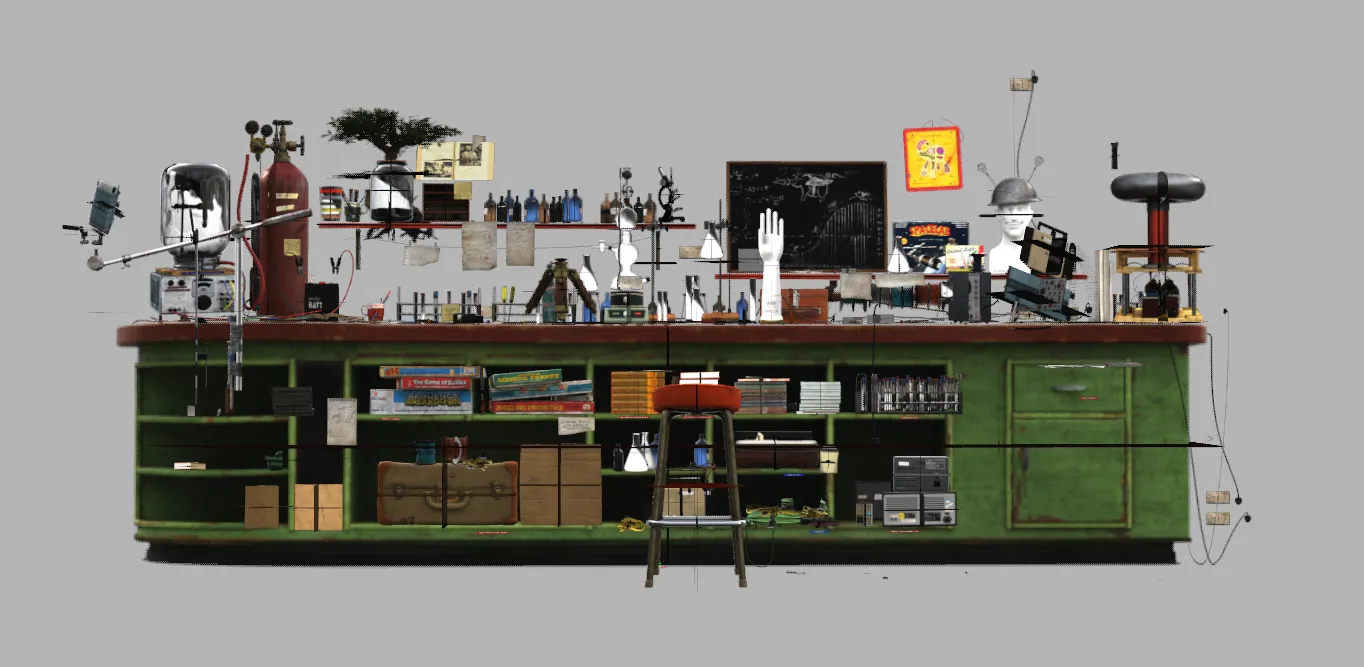At Animal Logic, we organise files into “Entities & Fragments” Libraries.
Note: If we weren’t using a custom asset resolver internally, we would probably use two
PXR_AR_DEFAULT_SEARCH_PATHs (pointing to/entityand/fragment) to make asset identification very simple.
High-level production concepts like Characters, Environments and Shots.
“Data Bundles,” such as Geometry (with various representations) or Materials & Textures (Looks).
Layers on the Entities, which connect the Fragments to the Entities. Those layers exist for each Pipeline Step (Department).
Fragments allow us to re-use data to reduce duplication of assets. For example, we can create “surfacing variations” by sharing the same geometry and rig, but using different looks:
We connect Entities to other Entities via the Assembly and Breakdown Fragments.
For an Environment entity to be populated with Setpiece entities, we use Assembly fragments:
At the shot level, the Breakdown Fragment brings entities such as Characters, Cameras or Environments.
Other fragments provide shot-specific overrides, for example:
Internally, we use more complex diagrams, such as the one below, to describe relationships between the files. We have many diagrams for various composition workflows, such as Characters, Matte Painting and Crowds.
Open in a new window for details.
The creation of Entities and Fragments is handled by our internal tool, Film Studio.
Whilst the terms above could be considered non-standard, we note that we’re not aware of an agreed-upon industry standard to use in place thereof (ie, even ftrack and ShotGrid use the term “Asset” to describe different concepts).
USD Adoption at Animal Logic initially started in 2017 in animation and was introduced across all departments in 2019.
We started by having versions of our geometry pipeline files encoded in USD (modelling geometry and animation caches), followed by using USD to represent the “relationships between assets” (introduction of Entities and Fragments pipeline). Then we updated lighting with USDLux in a full USD workflow. Then shading workflows to USDShade, and some of our previously existing instancing tools with PointInstancers.
A recent transition is adopting USDSkel for our crowds, charFX and animation library workflows.
The composition arcs choices have been driven by a balance between our USD knowledge and how much we can commit to change. We are always exploring ways of making our pipeline more flexible, robust and capable of meeting creative requirements from our shows.
This is an overview of some of the USD composition arcs we use in these assets. To walk through the examples, make sure to be on the main folder where the downloaded assets exist, e.g.:
cd ~/Downloads/ALab
For data that is potentially “heavy.” This data should generally be stored in crate (.usdc) files and generally does not refer to other files itself.
Usually, we use Payloads within the Fragment files. For example, for books_encyclopedias01:
usdview fragment/geo/modelling/books_encyclopedias01/geo_modelling_books_encyclopedias01.usda
Scene description data, such as variants, extentsHints or model kinds are kept “outside” the payloads so that they are available even when payloads are not loaded.
variantSet "geo" = {
"base" {
float3[] extentsHint = [(-6.79881, -0.040903993, -7.7824764), (7.272438, 18.345064, 6.9421234)]
over "GEO" (
payload = @base/mesh/geo_modelling_books_encyclopedias01_base_mesh_v010.usdc@
)
{
}
}
We split each variant into a different payload file, since those are usually created at different times in our pipeline, and some might depend on each other. For example, the display_high payload is automatically created in Houdini once a render_high payload is published from Maya.
Different workflows require different representations of the same data. We allow different clients to choose the most appropriate by exposing all possible representations via variantSets.
On the fragment books_encyclopedias01:
usdview fragment/geo/modelling/books_encyclopedias01/geo_modelling_books_encyclopedias01.usda
We can find several variants for the geo variantSet:
def Xform "root" (
prepend variantSets = "geo"
)
{
...
variantSet "geo" = {
"base" {
float3[] extentsHint = [(-6.79881, -0.040903993, -7.7824764), (7.272438, 18.345064, 6.9421234)]
over "GEO" (
payload = @base/mesh/geo_modelling_books_encyclopedias01_base_mesh.usdc@
)
{
}
}
"client_model" {
}
...
"render_high" (
variants = {
string geo_vis = "preview"
}
prepend variantSets = "geo_vis"
) {
...
}
Some variants exist only because we create the USD files from templates. In the future, we aim to improve the USD generation workflows to author only what is needed on a case-by-case basis, so we would not see empty “client_model” or “muscles” variants, unless required.
To know more about our variants in the pipeline, visit the Variants section.
References are like payloads, but “always loaded.” We use references to bring Fragments into Domain Layers.
For example, the Modelling Layer on prop books_encyclopedias01 references a geo fragment:
usdview entity/books_encyclopedias01/modelling/books_encyclopedias01_modelling.usda
We could have also used sublayers in many cases to achieve similar results as we usually reference the root prim.
def "root" (
prepend references = @../../../fragment/geo/modelling/books_encyclopedias01/geo_modelling_books_encyclopedias01.usda@
)
This is a scenario where “what arc to use” was driven by a historical technical reason. In this case, our geometry pipeline I/O required DCCs to refer to a “single root Xform” for the geometry files. Choosing sublayers instead required updates to our legacy pipeline, which we did not want to commit to do.
When more domains started transitioning to USD, most followed the reference approach for the sake of consistency. But, in cases where a sublayer or another arc solved a particular workflow, those deviations are embraced. For example, on shots, our fxcache fragments are sublayered and not referenced.
Sublayers are mainly used in our assets to add Domain Layers (departments or pipeline steps) to entities. For example, for the entity books_encyclopedias01, we have:
usdview entity/books_encyclopedias01/books_encyclopedias01.usda
subLayers = [
@surfacing/books_encyclopedias01_surfacing.usda@,
@modelling/books_encyclopedias01_modelling.usda@
]
Some Domain Layers have additional “subdomain” layers. For example, animbase and animfxcache subdomains are sublayers of the animation domain. We do this because our “department delivery” mechanism is tied to domains and animation needs to iterate internally on the subdomain before delivering the animation domain for downstream consumption.
Additionally, some fragments may be sublayered like the animfxcache and charfxcache ones, as can be seen on the provided shot mk020_0281:
usdview entity/mk020_0281/charfxcache
subLayers = [
@../../../fragment/fxcache/animfxcache/stoat_geo/mk020_0281_fxcache_animfxcache_stoat_geo.usda@,
@../../../fragment/fxcache/animfxcache/stoat_alfro/mk020_0281_fxcache_animfxcache_stoat_alfro.usda@,
@../../../fragment/fxcache/animfxcache/remi_geo/mk020_0281_fxcache_animfxcache_remi_geo.usda@
]
This decision came mainly from FX workflows, where a single FX fragment would theoretically be able to override any prim in a shot. Plus, the added convenience for ensuring their contributions are “stronger” than any previous department providing imageable prims.
We use the Specializes arc in a very different way to the other ones and for a very specific reason.
It ensures that the root prim of our entities has a type (Scope), while allowing domains to override it with a more appropriate type (e.g. Xform by modelling or SkelRoot by rigging for characters with USDSkel) via their referenced fragments.
In other words, an opinion, which is contributed via some complex composition arc (variant within a reference within a sublayer), needs to bring an opinion, which is stronger than the “local” opinion. So we consulted LIVRPS and chose the arc with the weakest strength to set the type. Now, we can just reference a rig fragment into the rigging layer of an entity and the root prim will change its type to skelRoot.
On the entity books_encyclopedias01:
usdview entity/books_encyclopedias01/books_encyclopedias01.usda
def "root" (
...
prepend specializes = </_root_type>
)
{
}
class Scope "_root_type" (
doc = "This prim holds the 'fallback' type of the default root prim"
)
{
}
We ensure the specialized _root_type prim is a class to let most workflows know they can “ignore it” for their common traversals.
The assets utilize USD purposes to switch between a lower resolution for OpenGL/viewport display and higher resolution for rendering. This means that users should only have to switch the purpose in the delegates’ settings and should not have to switch variants.
Please see the section on UsdPreviewSurface Materials below for more information.
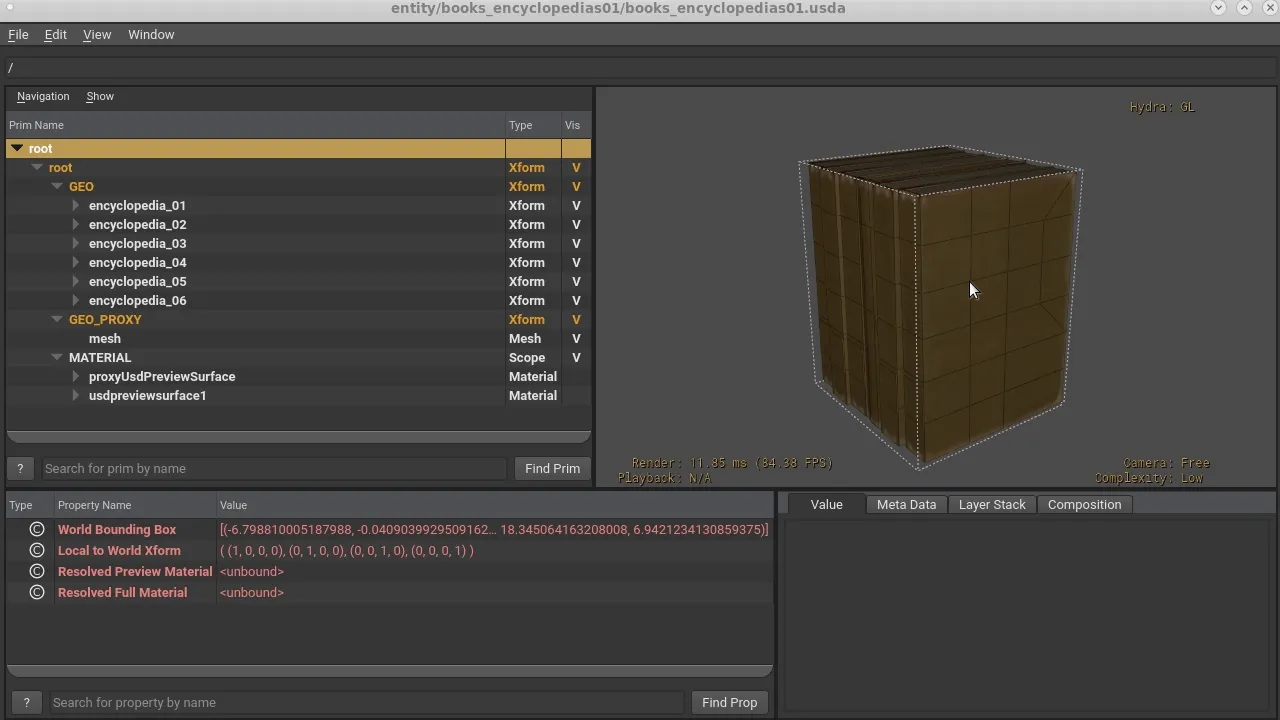
Animation and other shot departments often need to commence work on assets before they are surfaced.
We author displayColor and displayOpacity attributes in the Modelling department in Maya for this purpose.
Later on, when surfacing starts to supply materials, they will supersede the display colors and textures will appear in the viewport.
Each of the published entities (characters, props, environments) exposes variantSets on the default prim (e.g. geo, geocache, camera, skeleton, alfro, weave).
This allows consumers of those entities (mainly shot departments), to safely make variant selections on those root prims directly.
One nice aspect of variants is that there is a fallback mechanism that can be set programmatically when opening stages or via a plugin on the environment. We use both in our pipeline and this means we never publish characters, props or environments with internal variant selections. We always defer those selections to consumers of the entities via the mentioned mechanisms.
Note: We used to have look set with
render_highanddisplay_highvariants, but dropped it since we started authoring both preview and final renderopinionson the same “look” asset.
Since this started happening in the middle of a production, the main asset location remainedrender_high. So these lookfragmentscontain both “render” and “preview” shaders even though the filenames arerender_high.
All our geometry contributions (mainly coming from the Modelling domain), expose different representations of the same data for different consumers.
We provide 2 variant sets: geo and geo_vis.
| Variant | Usage |
|---|---|
| base | All of the geometry, with the exception of blendshape targets, that modelling artists author for downstream departments. |
| render_high | The main variant used for surfacing and shot departments for high-quality final frame rendering. |
| deform_high | The variant used by the rigging department to apply deformations. The output of that deformation gets “merged” on shots with the render_high geo variant. |
| display_high | Procedurally created low resolution version of the render_high geometry for fast preview while still retaining overall shape and colors. |
| pose | Mainly used by modelling for reviews where the character needs to be in a non-bind pose (e.g. relaxed, with style). This allows for modelling to not have to wait for rigging to see the character with an expressive pose. |
| shapes_high | All blendshape targets used by the performance rig, as well as for blendshapes in render_high, deform_high, pose variants’ creation. |
| client_model | When projects have incoming data from external clients, this is where that client version can be found. |
These variants in our pipeline shine with rigged entities (characters, props) and we’re excited to share some more examples in the future.
When modelling creates the base geometry, they can also provide a pose version for it, which will only override the points property:
usdview fragment/geo/modelling/books_encyclopedias01/pose/mesh/geo_modelling_books_encyclopedias01_pose_mesh.usdc
This will sublayer the render_high version and only override points properties:
#usda 1.0
(
defaultPrim = "GEO"
subLayers = [
@../../render_high/mesh/geo_modelling_books_encyclopedias01_render_high_mesh.usdc@
]
)
over "GEO"
{
over "encyclopedia_01"
{
over "encyclopedia1_cover_M_geo"
{
point3f[] points = [(-6.766857, -0.01848345, -5.47812), ..., (5.8743553, 18.286024, -5.140335)]
}
over "encyclopedia6_cover_M_geo"
{
point3f[] points = [(-6.6372204, 0.0063685314, 6.9421234), ..., (5.99792, 18.313019, 6.507246)]
}
}
}
This allows workflows to switch to the pose variant while retaining all render_high attributes like pref, displayColor and st.
We use this mainly for situations where we want to preview the entities with a bit of personality with the official geometry and before rigging and animation have worked on it.
This provides clients flexibility to switch visibility level between the render and proxy purposes on a per-entity level.
| Variant | Usage |
|---|---|
| default | Leave the render_high variant as it came from modelling. |
| preview | Use the display_high variant as a proxy of the render_high and set purposes appropriately. |
For example, an artist on a shot with a big environment might want to see on the viewport the “high-res” geometry version of a setpiece to interact with a character.
They can switch that setpiece to geo_vis=default to remove any render and proxy purpose opinions, while still being on the render_high variant.

When packaging, we compute extents for all geo fragments. This applies at the shot level as well, so you can have animated extentsHint properties.
This allows for unloaded stages to provide a preview of all bounding boxes in a shot, allowing for processes like frustum culling.
We payload all heavy data behind fragments as described on the Composition Arcs section.
USD’s composition of multiple opinions from different layers onto the same prim is usually desired. For example, a charFX layer might contribute a point attribute on a cloth prim, which overrides the point attribute, which animation has contributed.
However, on cameras, we decided that we usually don’t want to over opinions from the contributing departments (layout and animation), but prefer to see either one or the other. So cameras provide a “domain variant,” which allows the user to switch between the cameras authored by layout and animation.
Previously, we used in-house procedurals for instancing elements of environments (e.g. vegetation in a forest) as well as instancing elements of the vegetation (e.g. leaves, twigs, branches of trees).
We have updated those workflows to author native USD Point Instancers instead, which still give the ability of having nested instancing, plus give the benefit of multi-DCC support and the rest of the USD composition arcs.
You can find the point instancer under:
usdview fragment/spruce/modelling/vegetation_bonsai01/spruce_modelling_vegetation_bonsai01.usda
Or, with the lab opened, it is on prim at path:
/root/workbench_grp/vegetation_bonsai01_0001
The point instancers come with off and render variants under the variant sets spruce and spawn.
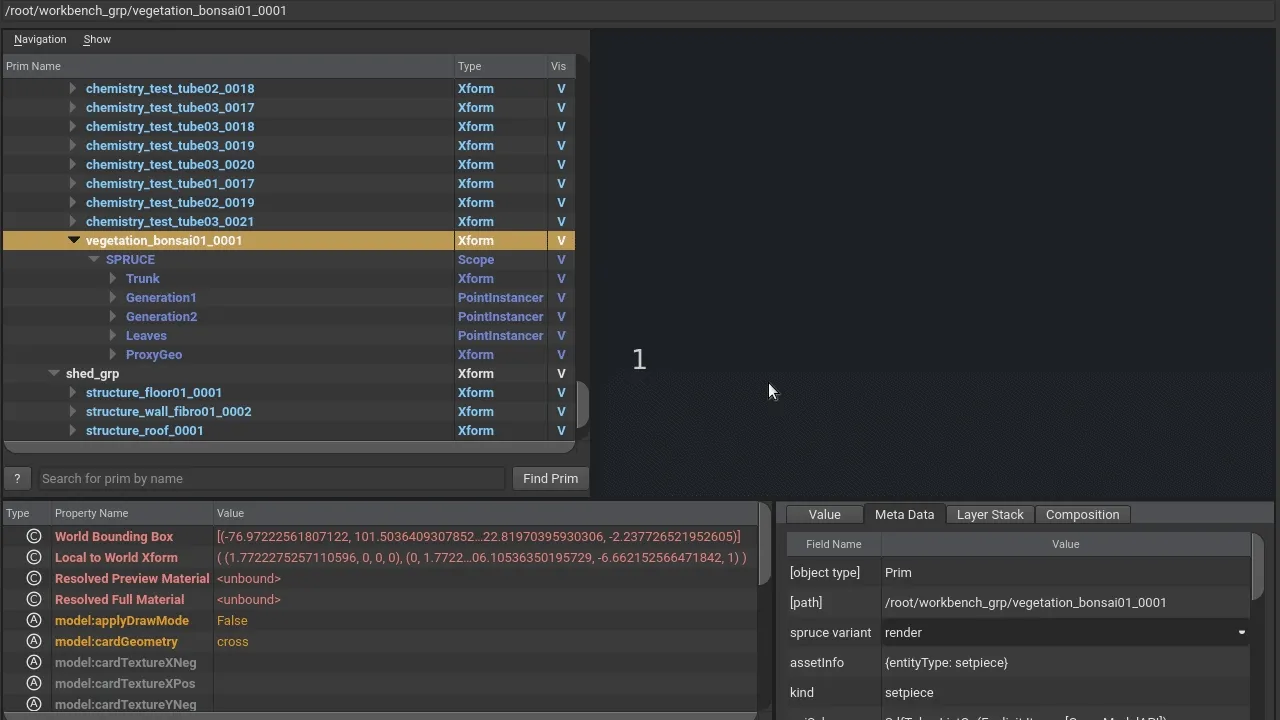
USDSkel is a bare-bones rig with simple skeletons and blendshapes. At Animal Logic, USDSkel is used for crowd workflows. It works well for this purpose as it is designed to be efficient and scalable, with a lack of shared joint influence and the ability to apply unique animations to instances without deinstancing.
This is represented in USD through skel primvars, which are a part of USD’s SkelBindingAPI.
fragment/perfrig/rigging/stoat01/base/rig/perfrig_rigging_stoat01_base_rig/skeleton/FX_skeleton.usdc
...
over "body_M_geo" (
prepend apiSchemas = ["SkelBindingAPI"]
)
{
matrix4d primvars:skel:geomBindTransform = ( (1, 0, 0, 0), (0, 1, 0, 0), (0, 0, 1, 0), (0, 0, 0, 1) )
int[] primvars:skel:jointIndices = << int[136160] >> (
elementSize = 10
interpolation = "vertex"
)
float[] primvars:skel:jointWeights = << float[136160] >> (
elementSize = 10
interpolation = "vertex"
)
uniform token[] skel:blendShapes
uniform token[] skel:joints = << TfToken[38] >>
rel skel:skeleton = </root/RIG/root_jnt>
}
...
This skeleton is exposed under a skeleton variantSet via the rig.usda layer:
usdview fragment/perfrig/rigging/stoat01/base/rig/perfrig_rigging_stoat01_base_rig/rig.usda
def "root" (
prepend variantSets = "skeleton"
)
{
variantSet "skeleton" = {
"off" {
}
"on" (
payload = @skeleton/FX_skeleton.usdc@
variants = {
string geo_vis = "default"
}
) {
}
}
}
When crowd departments use this as an agent, they choose the skeleton=on variant.
Primvars are a special attribute that a renderer can associate with a geometric primitive. They can vary across the primitive they are defined on through various interpolation rules, defined in the documentation.
For example, vertex defines the value to be interpolated across the vertices on the surface. Primvars can also be passed onto children of USD primitives. This makes them very flexible, which makes them effective as custom attributes for renderers (such as Animal Logic’s Glimpse) to read. You can read more about this in the AL-Specific documentation.
As seen in the USD snippet above, the SkelBindingAPI uses its skel primvars to allow joint weights and joint indices to vary across the same primitive with vertex interpolation.
One other primvar to note is the st primvar, which is how UVs are represented in Pixar’s USD. To work with them in DCCs like Houdini or Maya, they may need to be converted to uv. This can be seen when bringing something to SOPs from Houdini’s LOPs context through a sopmodify node, which includes a toggle to “Translate ST primvar to UV.”
Once characters or props are animated, the full animated geometry definition is stored on the geocache fragment.
The animation is represented through the time-sampled attributes in USD, including extent, normals, points, orientation, scale, and translation.
You can find this in the fragment/geocache folder, under either animbase or layout domain folders. These are also exposed as variant sets: animbase for the final animation, and layout for the general blocking.
In USD, the geocache heavy data is captured in the payload.usdc layer like:
usdview fragment/geocache/layout/stoat/render_high/cache/mk020_0281_geocache_layout_stoat_render_high_cache/payload.usdc
...
def Mesh "washer02_M_geo"
{
float3[] extent = [(-2.0686953, 9.217466, 6.9767714), (-1.9139013, 9.368373, 7.0265174)]
float3[] extent.timeSamples = {
<< 327 samples in [947, 1273] >>
}
...
normal3f[] normals = << GfVec3f[195] >>
normal3f[] normals.timeSamples = {
<< 327 samples in [947, 1273] >>
}
point3f[] points = << GfVec3f[195] >>
point3f[] points.timeSamples = {
<< 327 samples in [947, 1273] >>
}
...
quatf xformOp:orient:orient.timeSamples = {
<< 327 samples in [947, 1273] >>
}
float3 xformOp:scale = (1, 1, 1)
float3 xformOp:scale.timeSamples = {
<< 327 samples in [947, 1273] >>
}
double3 xformOp:translate = (0, 0, 0)
double3 xformOp:translate.timeSamples = {
<< 327 samples in [947, 1273] >>
}
uniform token[] xformOpOrder = ["xformOp:translate", "xformOp:orient:orient", "xformOp:scale"]
}
Exposed under a geocache variant set, which payloads the data under the geo=render_high variant on the cache.usda layer:
over "root" (
variants = {
string geocache = "animbase_render_high"
}
prepend variantSets = "geocache"
)
{
variantSet "geocache" = {
"animbase_render_high" (
variants = {
string geo = "render_high"
}
prepend variantSets = "geo"
) {
variantSet "geo" = {
"render_high" (
payload = @payload.usdc@
) {
}
This way, at any point one can pick different per-department animated contributions (for example, layout and animation).
Since the introduction of USDSkel, whenever the skeleton variant exists in our characters, at geocache creation time an additional skeleton techvar cache is created:
usdview fragment/geocache/animbase/stoat/skeleton/cache/mk020_0281_geocache_animbase_stoat_skeleton_cache/payload.usdc
over "root"
{
custom string assetVersionId = "1714672323"
over "RIG"
{
over "Animation"
{
token[] joints = << TfToken[44] >>
quatf[] rotations = << GfQuatf[44] >>
quatf[] rotations.timeSamples = {
<< 327 samples in [947, 1273] >>
}
half3[] scales = << GfVec3h[44] >>
float3[] translations = << GfVec3f[44] >>
float3[] translations.timeSamples = {
<< 327 samples in [947, 1273] >>
}
This is exposed as a variantSet similar to the render_high techvar:
over "root" (
variants = {
string geocache = "animbase_render_high"
}
prepend variantSets = "geocache"
)
{
variantSet "geocache" = {
"animbase_skeleton" (
variants = {
string skeleton = "on"
}
prepend variantSets = "skeleton"
) {
variantSet "skeleton" = {
"on" (
payload = @payload.usdc@
) {
}
The existence of this variant allows our crowd workflows to pick any contribution from animation as “clip” data for the crowd agents.
The charFX cache is the result of simulation (done by the charFX team), which runs for resolving collision or dynamics (for example, between cloth and skin). It is usually a value clip containing minimal data, such as point positions, but it may also include topology data if the meshes or curves are increased in resolution whilst simulated.
In terms of the USD structure, the “heavy” simulated data is stored in chunks for one or more frames. For example:
fragment/fxcache/charfxcache/stoat_alfro/base/cache/mk020_0281_fxcache_charfxcache_stoat_alfro_base_cache/payload/animated_data.1004.usdc
This will mainly include the animated (and sometimes redefined, when subdivided) properties of the simulated prims:
over "alfro_tail_main"
...
{
def BasisCurves "curves"
{
...
int[] curveVertexCounts = << int[1652] >>
float3[] extent.timeSamples = {
1004: [(8.048013, 0.5993955, -13.944824), (18.102667, 10.497459, -1.5134108)],
}
point3f[] points (
interpolation = "vertex"
)
These chunked files are aggregated together via a value clip with the clip.usda, clip.manifest.usda and clip.topology.usda files:
over "GEO" (
clips = {
dictionary alfro = {
double2[] active = [(1004, 0), ..., (1057, 53)]
asset[] assetPaths = [
@payload/animated_data.1004.usdc@,
...,
@payload/animated_data.1057.usdc@
]
asset manifestAssetPath = @./clip.manifest.usda@
string primPath = "/root/stoat/body_M_hrc/GEO"
double2[] times = []
}
These are then payloaded in the cache.usda file:
over "body_M_hrc" (
append variantSets = "geo"
)
{
variantSet "geo" = {
"render_high" {
over "GEO" (
prepend payload = @./clip.usda@</root/stoat/body_M_hrc/GEO>
)
{
}
The animfxcache fragment is fairly the same as charfxcache, with the difference being that animfxcache runs automatically when a character has has a global FX rig ready to run without human intervention on shots.
For more information on bringing value clips together, see Sequencable, Re-timable Animated “Value Clips” and the usdstitchclips command line tool.
We provide the cached camera of the shot, which has a frame range of:
In the given scene, the bonsai entity: vegetation_bonsai01 provides “keep alive” behaviour. This means that it has a “loopable” animation on the instances, which makes it come to life.
We achieve this via value clips in USD on spruce_modelling_vegetation_bonsai01_base_groom:
usdview fragment/spruce/modelling/vegetation_bonsai01/base/groom/spruce_modelling_vegetation_bonsai01_base_groom/groom.usda
(
...
defaultPrim = "root"
endTimeCode = 100
framesPerSecond = 24
metersPerUnit = 1
startTimeCode = 1
subLayers = [
@clip.usda@,
@payload.usdc@
]
timeCodesPerSecond = 24
)
This sublayers clip.usda, where we can see the clip data:
over "root" (
clips = {
dictionary default = {
double2[] active = [(1, 0), (100, 0), ..., (5000, 0)]
asset[] assetPaths = [@payload.usdc@]
string primPath = "/root"
double2[] times = [(1, 1), (100, 100), ..., (5000, 51)]
}
...
In phase 2, you can also see a value clip used for the baked procedurals of McFerretson’s fur.
Value clips allow timesampled animation to be assembled from a variety of sources, which is effective for scalability. To learn more about value clips you can visit Pixar’s Docs.
At Animal Logic we make heavy use of instancing whenever possible. By default, all entities used on an environment are instanced.
This means if we use the same seven windows on a city, they all share the same prototype prim. ALab is no exception, these are the most frequently used entities (all of which are instanced):
| Entity | Instance Count |
|---|---|
| chemistry_test_tube03 | 21 |
| chemistry_test_tube02 | 18 |
| chemistry_test_tube01 | 17 |
| chemistry_bottle03 | 10 |
| chemistry_beaker_rack01 | 8 |
usdview fragment/assembly/modelling/thelab01/assembly_modelling_thelab01.usda
Key observations:
prim - on the component (entity) root by setting instanceable = true.Overrides are applied on the same prim.instancing layouts, such as instancing the geo scopes and the materials. def Xform "chemistry_test_tube03_0001" (
instanceable = true
prepend references = @../../../../entity/chemistry_test_tube03/chemistry_test_tube03.usda@
)
{
... # transformation overrides
}
def Xform "chemistry_test_tube03_0002" (
instanceable = true
prepend references = @../../../../entity/chemistry_test_tube03/chemistry_test_tube03.usda@
)
{
... # transformation overrides
}
usdview fragment/look/surfacing/decor_tripod_tabletop01/render_high/binding/look_surfacing_decor_tripod_tabletop01_render_high_binding/render_high.usda
Geo with proxy display purpose utilizes simplified UVs primvars:st and a material usd_proxy parameterised with BaseColor texture baked from the highres texture to 512x512px jpeg.

Geo with render purpose utilizes two UV sets:
usd_preview material is bound to the prims via material:binding:preview binding and the material is parameterised with a single UDIM BaseColor and Opacity jpeg 1k textures, which seem to work well for opaque and transparent objects’ viewport display.
Textures are in OCIO: Utility - sRGB - Texture.
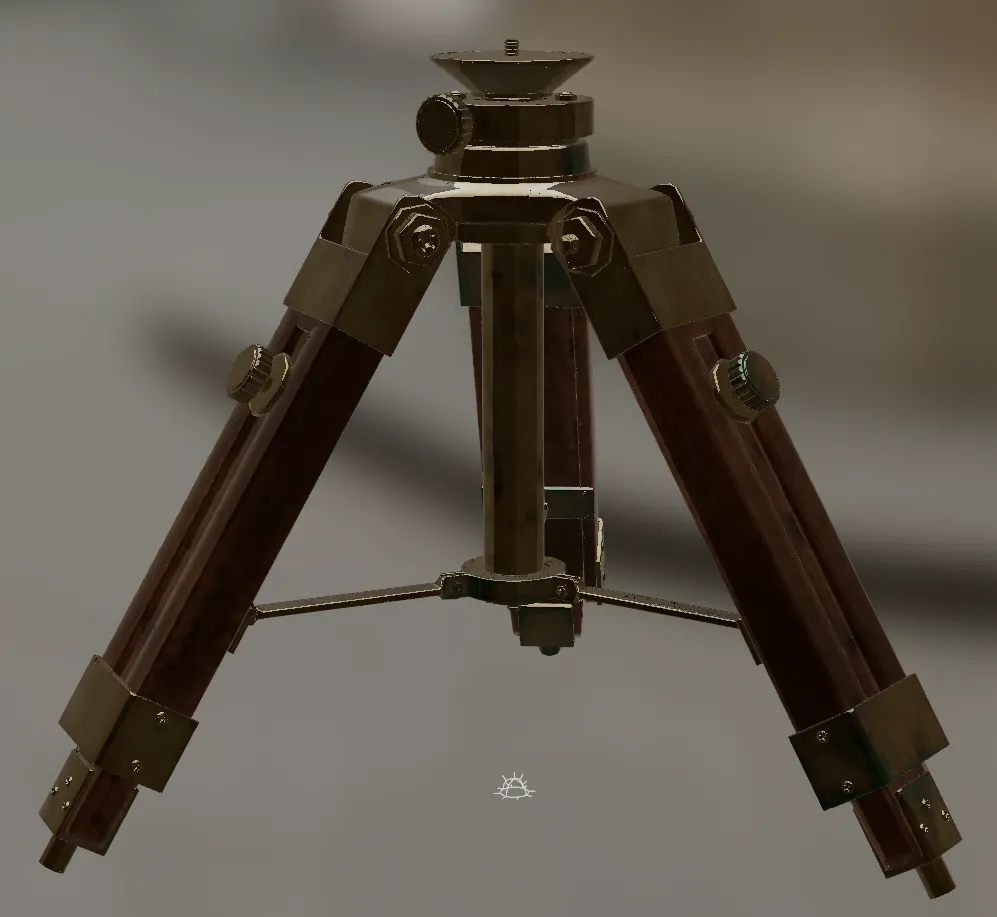
usd_full material is bound to prims via material:binding:full binding and the materials are parameterized with multi-UDIM 1k half float mip-mapped OpenEXR images in ACEScg colour space.
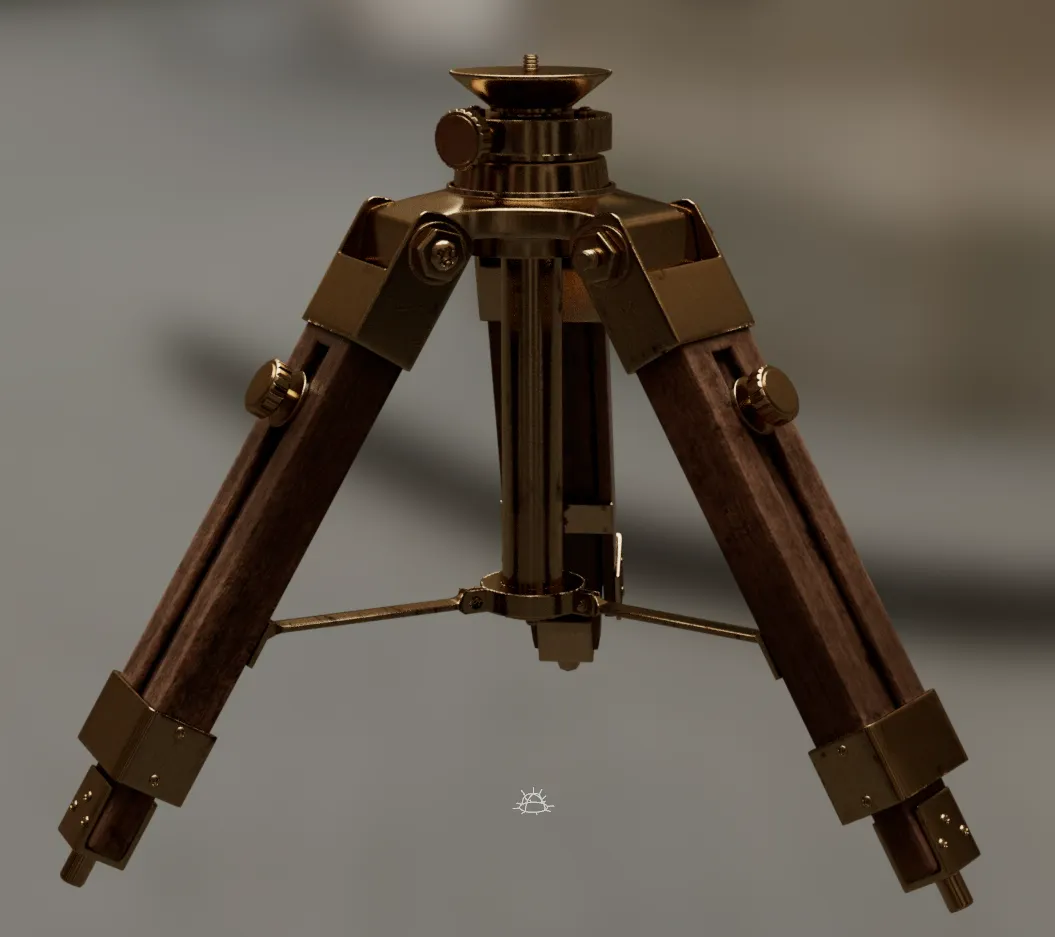
Note: We also provide an additional set of higher resolution textures (4k) to simulate more real-world “production rendering.” It can be downloaded from ALab Downloads.
The final-quality production light rig used for Glimpse renders has been included, and has been automatically adapted for closer compliance to UsdLux conventions.
Internally, the lighting layer is generated by our procedural USD-authoring system, Grip.
On the provided scene, the main lights are located under the /root/lightrig01 prim, and a few “asset light rigs” can be found under the hierarchy of selected assets, such as the oscilloscope. Shadow-linking exclusions are used for the windows and skydome prims, and some light-linking is used on the asset rigs. Light filters (such as blockers) are not used. Several different light types are used including DomeLight, DistantLight, RectLight, DiskLight, SphereLight and CylinderLight.
A class inherits arc is used to apply the same light rig to multiple instances of assets without breaking instancing, e.g. the portable_tv. prims.
Note: When you open the scene in
USDView, you may get some warnings stating that there is no support for the following primtypes in hydra storm renderer:CylinderLight,DiskLightandDistantLight.
Render procedurals such as hair (Alfro) and cloth (Weave) have been expanded into the thousands of curves that their Glimpse-specific render procedural USD data represents. This way they can also be rendered by your renderer. Their original proxy geometry remains, with their UVs transferred onto the curves so they can be textured.
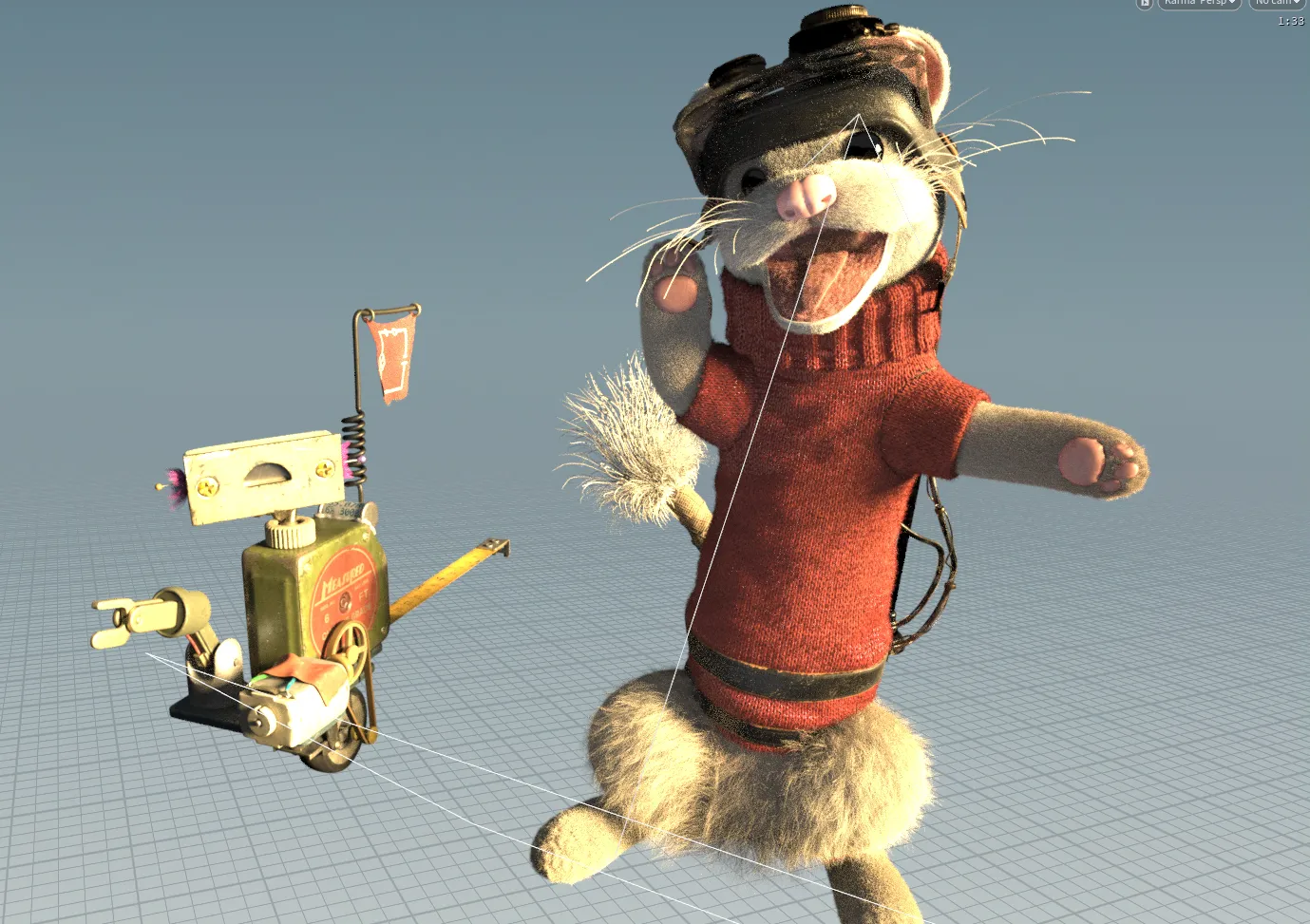
These curves are represented by USD overrides and stored in baked_procedurals.usd. They overwrite the original Animal Logic procedural data designed for Glimpse with a prim <procedural_root_prim>/procedurals/output/curves.
These curves should be visible by switching to a view with display purpose render. In USDView, you can navigate to View > Display Purposes > Render.
Note: Textures are not visible on curves in
USDView- the above image was rendered in Houdini’s Karma renderer.
The ability to set entities draw mode to card drastically increases viewport performance. Global entities of component Kind have textures for “cards” Draw Mode.
For cards Draw Mode to work, we need to have a few attributes authored:
model.applyDrawMode: Suggests at what level the Draw Mode will be applied. A value of True means that an assembly will be set as a whole. A value of False will overwrite this.
model.cardGeometry: Dictates the type of cards to use. Default is box.
model.cardTexture(XYZ)(PosNeg): Texture path values that are used to generate the actual cards. If no values are set, a card won’t be drawn. If a card value is given a positive, but not a negative, then it will only use one side.
model.drawMode: This is the Draw Mode that needs to be selected. To use this, set the drawMode to cards.
